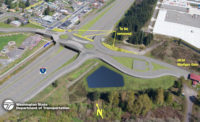It took 80-ft-deep, dense soil for “Bertha,” the world’s largest-diameter tunnel-boring machine, to finally hit her stride. After three-plus years of delays, at least $220 million in cost overruns, and concerns about machine durability and ground movement, the past seven months have proven to be clear dirt-churning as the Washington State Dept. of Transportation attempts to replace the Alaskan Way Viaduct in downtown Seattle with a 1.7-mile-long bored tunnel.
Now halfway through the 9,270-ft-long journey to the north portal near the Space Needle and moving at a rate of about 15 millimeters per minute, Bertha’s path under First Avenue puts tunneling on track to finish in 2017, enabling the entire project to open to traffic in early 2019.
“Things are going pretty well,” says Chris Dixon, project manager for Seattle Tunnel Partners. “I think the soil conditions have improved dramatically.”
Dixon says Seattle’s waterfront—shallow soils, dumped in place—proved problematic. “We knew the ground would be difficult to control, but as we made our way up Alaskan Way we gradually got deeper,” he says. “We dove underneath the viaduct [passing 15 ft below its foundation]. From that point forward, we have been in glacial, overly consolidated soils where, before, we were in the underconsolidated soils.”
The denser, firmer soils enhance the team’s ability to control the pressures and ground. Soil under the viaduct was a clay-like material, but now it has transitioned to a section of abrasive alluvial material, expected for the balance of the drive.
Seattle Tunnel Partners has slowed the TBM, which is rotating its 57.5-ft-dia cutterhead once a minute, from a penetration rate of about 25 to 30 mm per minute in clay to about 15 mm per minute. Dixon says, “The machine is performing well, and the operating parameters are right where we want them to be.”
Joe Hedges, WSDOT program administrator for the Alaskan Way Viaduct Replacement Program, says the slow pace protects, maintains and preserves the TBM. The new type of soil imposes additional wear on the cutterhead, though. Bertha contains two types of tools on the cutterhead. Some 100 precutting bits—which weigh 600 lb each and are mounted mostly in pairs along the spokes of the head—are the first piece of Bertha to touch the soil, cutting and loosening material at the face of the tunnel. The second type of bit—much smaller, at about 75 lb each—resides along the openings of the cutterhead between the spokes.
Dixon says two more stops are planned to inspect and replace the smaller tools using hyperbaric intervention, but the team expects they may have additional stoppages along the way to deal with the larger bits, which can be changed out under ambient atmospheric pressure.
The bits farthest from the center of the cutterhead wear quickly because they travel farther. During a recent two-week stop, crews replaced 14 of the large bits, all on the cutterhead’s outer fourth.
The larger bits “wear down the more work the scraper bits have to do and the quicker they wear down,” Dixon says. “We made the decision to stop and change precutting bits so that the machine would operate as intended and not wear down scraper bits.”
As Bertha moves forward, crews install tunnel rings behind, with more than 669 installed to date. Next, crews place a corbel at each side of the tunnel to support the lower wall of the roadway and, ultimately, the lower deck. Crews currently place two opposite-facing corbels at the same time with the lower walls. Next, crews install the cast-in-place upper deck before moving back to corbels the following day. Fifty-four-ft-long concrete placements are advancing the interior structure 27 ft a day. With more than 3,000 ft completed, the interior structure is about 1,000 ft behind the tunnel rings.
“The interior structure keeps moving forward on a daily basis,” Dixon says. “When the TBM mines at a faster rate, it gets out ahead. But when it stops for maintenance, the interior will keep up.”




Post a comment to this article
Report Abusive Comment